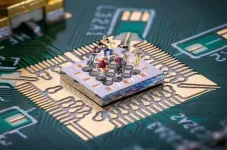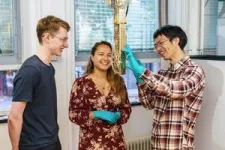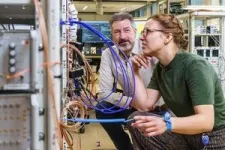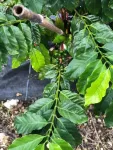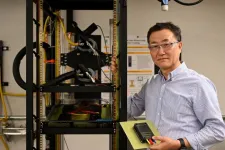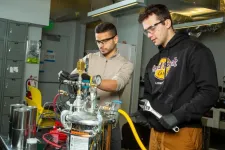(Press-News.org) Researchers at QuTech developed somersaulting spin qubits for universal quantum logic. This achievement may enable efficient control of large semiconductor qubit arrays. The research group published their demonstration of hopping spins in Nature Communications and their work on somersaulting spins in Science.
In 1998, Loss and DiVincenzo published the seminal work ‘quantum computation with quantum dots’. In their original work, hopping of spins was proposed as a basis for qubit logic, but an experimental implementation has remained lacking. After more than 20 years, experiments have caught up with theory. Researchers at QuTech —a collaboration between the TU Delft and TNO— have demonstrated that the original ‘hopping gates’ are indeed possible, with state-of-the-art performance.
Making control simple
Qubits based on quantum dots are studied worldwide as they are considered a compelling platform for the construction of a quantum computer. The most popular approach is to trap a single electron and to apply a sufficiently large magnetic field, allowing the spin of the electron to be used as a qubit and controlled by microwave signals.
In this work, however, the researchers demonstrate that no microwave signals are needed. Instead, baseband signals and small magnetic fields are sufficient to achieve universal qubit control. This is beneficial because it can significantly simplify the control electronics required to operate future quantum processors.
From hopping to somersaulting qubits
Controlling the spin requires hopping from dot to dot and a physical mechanism capable of rotating it. Initially, the proposal of Loss and DiVincenzo uses a specific type of magnet, which proved difficult to realize experimentally. Instead, the group at QuTech pioneered germanium. This semiconductor conveniently may by itself already allow for spin rotations. This is motivated by work published in Nature Communications, where Floor van Riggelen-Doelman and Corentin Déprez of the same group show that germanium can serve as a platform for hopping of spin qubits as a basis to make quantum links. They observed first indications of spin rotations.
When considering the difference between hopping and somersaulting qubits, think of quantum dot arrays as a trampoline park, where electron spins are like people jumping. Typically, each person has a dedicated trampoline, but they can hop over to neighbouring trampolines if available. Germanium has a unique property: just by jumping from one trampoline to the next, a person experiences a torque that makes them somersault. This property allows researchers to control the qubits effectively.
Chien-An Wang, first-author of the Science paper, specifies: “Germanium has the advantage of aligning spins along different directions in different quantum dots.” It turned out that very good qubits can be made by hopping spins between such quantum dots. “We measured error rates less than a thousand for one-qubit gates and less than a hundred for two-qubit gates.”
Somersaulting qubits in a trampoline park
Having established control over two spins in a four-quantum dot system, the team took it a step further. Instead of hopping spins between two quantum dots, the team also investigated hopping through several quantum dots. Analogously, this would correspond to a person that is hopping and somersaulting over many trampolines. Co-author Valentin John explains: “For quantum computing, it is necessary to operate and couple large numbers of qubits with high precision”.
Different trampolines make people experience different torques when jumping, and similarly, hopping spins between quantum dots also result in unique rotations. It is thus important to characterize and understand the variability. Co-author Francesco Borsoi adds: “We established control routines that enables to hop spins to any quantum dot in a 10-quantum dot array, which allows us to probe key qubit metrics in extended systems”.
Team effort
“I am proud to see all the teamwork” principal investigator Menno Veldhorst sums up. “In a time span of a year, the observation of qubit rotations due to hopping became a tool that is used by the entire group. We believe it is critical to develop efficient control schemes for the operation of future quantum computers and this new approach is promising.”
END
Spin qubits go trampolining
Researchers at QuTech developed somersaulting spin qubits for universal quantum logic
2024-07-25
ELSE PRESS RELEASES FROM THIS DATE:
Seven steps to achieving the right to clean indoor air post-pandemic
2024-07-25
Professor Morawska, director of THRIVE, from QUT’s School of School of Earth and Atmospheric Sciences said the rapid global spread of Covid-19 had soon made it clear the world was unprepared to respond appropriately.
“In the early days of the pandemic the World Health Organisation and many national health authorities claimed the virus was ‘not in the air’ but rather present in large quantities on surfaces. This led to a misconception about how the virus was transmitted,” ...
Scientists study how to bring you ‘climate-smart coffee’
2024-07-25
Crave that cup of coffee in the morning? Globally, consumers drink more than 2.2 billion cups daily. Someone grows all that joe: More than 100 million farmers worldwide produce coffee.
Coffee beans consumed across the globe come from two species: Coffea arabica and Coffea canephora, also known as Robusta (or Conilon) coffee. Historically, coffee drinkers prefer Arabica beans for their specific flavor and aroma, said Felipe Ferrao, a University of Florida research assistant scientist in horticultural sciences.
But by 2050, about 80% of Arabica production is predicted to decrease because of climate change. So, Ferrao and colleagues from France (RD2 Vision) and Brazil (Incaper ...
New study shows at-home colon cancer screening test reduces risk of colorectal cancer death, as effective as screening colonoscopy
2024-07-25
COLUMBUS, Ohio – A noninvasive colorectal cancer screening test that can be done at home could reduce the risk of colorectal cancer death by 33%, according to a new study published in JAMA Network Open. This is the first study to evaluate this tool’s effectiveness in specific racial groups.
For this study, researchers at The Ohio State University Comprehensive Cancer Center – Arthur G. James Cancer Hospital and the Richard J. Solove Research Institute (OSUCCC – James), and Kaiser Permanente evaluated data from nearly 11,000 patients who underwent at-home FIT (fecal immunochemical testing) among ...
A cool solution
2024-07-25
Artificial intelligence (AI) is hot right now. Also hot: the data centers that power the technology. And keeping those centers cool requires a tremendous amount of energy.
The problem is only going to grow as high-powered AI-based computers and devices become commonplace. That’s why University of Missouri researcher Chanwoo Park is devising a new type of cooling system that promises to dramatically reduce energy demands.
“Cooling and chip manufacturing go hand-in-hand,” said Park, a professor of mechanical and aerospace engineering in the Mizzou College of Engineering. “Without proper cooling, components overheat and fail. Energy-efficient data centers will be key ...
Electrical currents may make body’s cancer-killing cells even better killers
2024-07-25
Scientists have discovered that electrical currents may make Natural Killer (NK) cells – our very own cancer-killing immune cells – even better killers, which could have significant implications for treating some cancers.
The scientists found that Tumour Treating Fields (TTF) in the laboratory (which mimic exposure of brain tumours to electric currents via a simple hat worn by patients) evoked an even more deadly response from NK cells. They hope their promising findings may open the door to new combined therapies for people living with certain brain tumours, such as glioblastoma.
Glioblastoma is an aggressive, common ...
In Illinois, ‘older adults are at increased risk for suicide’
2024-07-25
Most (83%) suicide deaths were among men
Firearms were the most frequently used weapon (59%)
Among those who died by suicide, 20% had been diagnosed with depression; only 14.1% of them were receiving treatment
CHICAGO --- Nearly 20% of suicides in Illinois between 2020 and 2021 were among people 65 years and older, according to recently released data from Northwestern University Feinberg School of Medicine. The suicides disproportionately affected white men between the ages of 65 and 74 years, with ...
Raindrops grow with turbulence in clouds
2024-07-25
Scientists for decades have attempted to learn more about the complex and mysterious chain of events by which tiny droplets in clouds grow large enough to begin falling toward the ground. Better understanding this process, known as the “rain formation bottleneck,” is fundamental to improving computer model simulations of weather and climate and ultimately generating better forecasts.
Now a research team led by scientists at the U.S. National Science Foundation National Center for Atmospheric Research (NSF NCAR) ...
Penn researchers reveal how a bacterium supports healing of chronic diabetic wounds
2024-07-25
PHILADELPHIA – There are many important reasons for keeping cuts and sores clean, but new research from the Perelman School of Medicine at the University of Pennsylvania shows that a certain bug, Alcaligenes faecalis (A. faecalis), can facilitate healing of hard-to-treat wounds among people with diabetes. While there are many studies done on potentially harmful bacteria in wounds, the researchers discovered that A. faecalis, a bacterium found in many types of chronic wounds, actually boosts healing of diabetic wounds. The researchers found that the beneficial bacterium can promote ...
A recipe for zero-emissions fuel: Soda cans, seawater, and caffeine
2024-07-25
A sustainable source for clean energy may lie in old soda cans and seawater.
MIT engineers have found that when the aluminum in soda cans is exposed in its pure form and mixed with seawater, the solution bubbles up and naturally produces hydrogen — a gas that can be subsequently used to power an engine or fuel cell without generating carbon emissions. What’s more, this simple reaction can be sped up by adding a common stimulant: caffeine.
In a study appearing today in the journal Cell Reports Physical Science, the researchers show they can produce hydrogen gas by dropping pretreated, pebble-sized aluminum pellets into a beaker ...
Study suggests preoperative iron infusions work better than blood transfusions for some anemic patients
2024-07-25
In a rigorous medical records study covering tens of thousands of patients, Johns Hopkins Medicine researchers conclude that some patients with preoperative anemia have better outcomes if they get iron infusions before surgery rather than standard red blood cell transfusions.
The findings, published July 22 in Anesthesia & Analgesia, contribute to mounting evidence that such iron infusions, which boost the production of a person’s own red blood cells, are better than relying on someone else’s blood.
“Anemia ...
LAST 30 PRESS RELEASES:
Numbers in our sights affect how we perceive space
SIMJ announces global collaborative book project in commemoration of its 75th anniversary
Air pollution exposure and birth weight
Obstructive sleep apnea risk and mental health conditions among older adults
How talking slows eye movements behind the wheel
The Ceramic Society of Japan’s Oxoate Ceramics Research Association launches new international book project
Heart-brain connection: international study reveals the role of the vagus nerve in keeping the heart young
Researchers identify Rb1 as a predictive biomarker for a new therapeutic strategy in some breast cancers
Survey reveals ethical gaps slowing AI adoption in pediatric surgery
Stimulant ADHD medications work differently than thought
AI overestimates how smart people are, according to HSE economists
HSE researchers create genome-wide map of quadruplexes
Scientists boost cell "powerhouses" to burn more calories
Automatic label checking: The missing step in making reliable medical AI
Low daily alcohol intake linked to 50% heightened mouth cancer risk in India
American Meteorological Society announces Rick Spinrad as 2026 President-Elect
Biomass-based carbon capture spotlighted in newly released global climate webinar recording
Illuminating invisible nano pollutants: advanced bioimaging tracks the full journey of emerging nanoscale contaminants in living systems
How does age affect recovery from spinal cord injury?
Novel AI tool offers prognosis for patients with head and neck cancer
Fathers’ microplastic exposure tied to their children’s metabolic problems
Research validates laboratory model for studying high-grade serous ovarian cancer
SIR 2026 delivers transformative breakthroughs in minimally invasive medicine to improve patient care
Stem Cell Reports most downloaded papers of 2025 highlight the breadth and impact of stem cell research
Oxford-led study estimates NHS spends around 3% of its primary and secondary care budget on the health impacts of heat and cold in England
A researcher’s long quest leads to a smart composite breakthrough
Urban wild bees act as “microbial sensors” of city health.
New study finds where you live affects recovery after a hip fracture
Forecasting the impact of fully automated vehicle adoption on US road traffic injuries
Alcohol-related hospitalizations from 2016 to 2022
[Press-News.org] Spin qubits go trampoliningResearchers at QuTech developed somersaulting spin qubits for universal quantum logic
